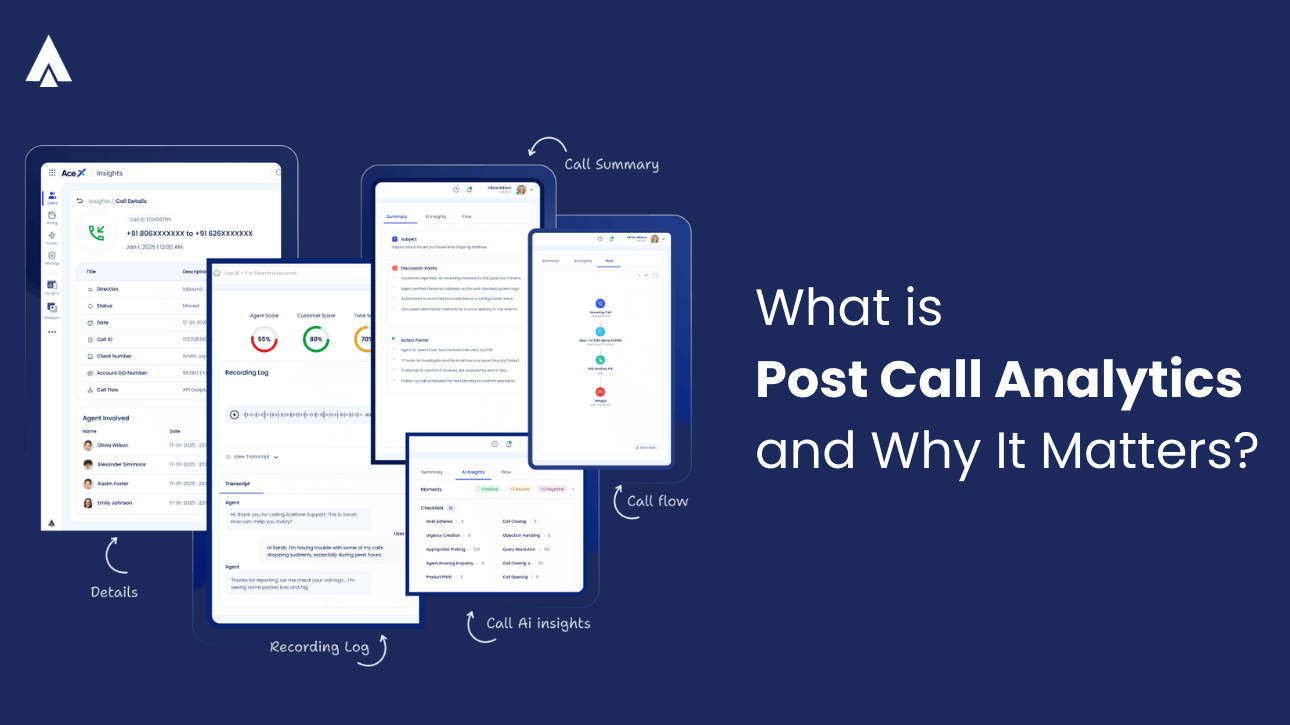Your contact center handled 1500+ calls last week. Your team hit their average handle time targets. CSAT scores held steady at 4.2 out of 5. But your VP just asked why three enterprise deals stalled in the final stage? Now you’re staring at a dashboard that can’t answer the question.
Here’s the uncomfortable truth: most contact centers are data-rich but insight-poor.
Every conversation contains patterns like objection triggers, coaching opportunities, compliance risks, and product feedback. But without systematic analysis, these signals disappear into the void. Post-call analytics bridges this gap, transforming completed interactions from archived recordings into strategic intelligence that drives measurable business outcomes.
This isn’t about generating more reports. It’s about answering the questions that actually matter:
- Why are customers calling?
- What separates your top performers from the rest?
- Where is revenue leaking through preventable mistakes?
Let’s explore how post-call analytics shifts contact centers from reactive firefighting to proactive optimization.
What is Post-Call Analytics?
Post-call analytics in contact centers is the systematic examination of completed customer interactions. It analyzes recordings, transcripts, metadata, and associated CRM data to extract actionable patterns in customer conversations.
Unlike real-time analytics that prioritize speed, post-call analytics emphasizes depth. Think of it as the difference between watching a single play unfold and studying game film to understand team strategy. The former helps agents at the moment; the latter reveals what’s working, what’s failing, and why.
Here’s how post call analytics works:
- Data collection: The platform stores all call recordings, and associated details in a centralized system for later review.
- Call monitoring: These recordings are examined to better understand customer needs and evaluate how well agents handle interactions.
- Data preprocessing: The audio is transcribed using automatic speech recognition (ASR), and the resulting text is cleaned and formatted for deeper analysis.
- Sentiment analysis: NLP models evaluate the tone of the conversation, detecting emotions such as satisfaction, confusion, or frustration.
- KPI extraction: The platform then pulls key metrics like call duration, time on hold, and the number of transfers to measure agent effectiveness.
- Trend identification: Machine learning tools sift through large volumes of data to uncover repeating issues and new patterns.
- Root cause analysis: By examining the content and context of conversations, the system uncovers the core drivers behind common problems.
- Reporting and visualization: Finally, the platform compiles all the insight into comprehensive dashboards and visual reports.
Core Components of Post Call Analytics
Post-call analytics is a crucial feature offered with most modern contact center software. It operates across three interconnected layers:
Intelligence Layer
Advanced speech analytics can automatically transcribe customer conversations. You also get speaker separation, sentiment analysis, and keyword identification. To ensure a smooth conversation flow, PCA also flags moments of silence or talk-over patterns. This foundation converts unstructured audio into analyzable data.
Analysis Layer
After the call insights are captured, the sophisticated algorithms working in the background score the conversations. They rate each interaction against team averages and top performers based on conversation complexity. The algorithm also ensures that your team complies with industry regulations.
Action Layer
The system generates personalized coaching recommendations tied to specific conversation moments. It integrates insights into existing workflows through CRM and ticketing systems. And for critical events like compliance violations or escalations, the man gets informed via notification triggers.
What Are the Benefits of Post-Call Analytics?
Now that you understand how post-call analytics works and its core components, let’s take a step further. With such in-depth insights at your disposal, you can improve all aspects of your call center management.
For example, if analytics reveal that 38% of callers mention “difficulty resetting their password,” you can immediately update your IVR to include a self-service password reset option. You can also train agents on a faster troubleshooting workflow and send a targeted follow-up email guide to affected customers.
That was just the tip of the iceberg. Let’s explore other benefits of post-call analytics in contact centers.
1. Helps Prevent Revenue Leaks
Every quarter, opportunities slip through unnoticed. A support agent misses an upsell signal from an expanding customer. A sales rep fails to address a deal-killing objection because they didn’t recognize it as critical. Post-call analytics identifies these invisible losses.
By analyzing conversation patterns across won and lost deals, you can identify the objection types that correlate with deal failure. You can spot the hints your customers might be dropping about expansion, like asking about your product’s “maximum” capacity.
2. Operational Efficiency at Scale
Generic training sessions waste your team’s time and your company’s budget. Without conversation-level visibility, you’re merely guessing which skills need development. Agent performance analytics changes this equation entirely.
Post-call systems benchmark each agent against team standards across dozens of micro-behaviors: greeting consistency, active listening indicators, objection handling techniques, closing effectiveness.
Instead of telling an entire team to “improve call quality,” you can deliver targeted feedback: “Sarah, you’re excellent at building rapport but consistently miss opportunities to confirm next steps before closing.”
3. Ensures Consistency in Customer Experience
According to a recent HubSpot Research, 59% of customers would recommend your brand to a friend because of quality customer service. This makes providing exceptional customer experience non-negotiable.
Your brand might be making big promises of delighting customers every step of the way. However, your contact center could either be delivering on them or not. Post-call analytics provides the evidence.
It can help you analyze conversation sentiment, compliance with brand guidelines, and consistency of information provided by various agents. You can use that data to identify experience gaps that drive churn. Did customers who canceled receive different treatment than those who stayed? Are certain agent cohorts systematically providing incomplete information?
4. Regulatory Compliance and Risk Mitigation
In regulated industries (financial services, healthcare, insurance), call recording analysis isn’t optional. You need to first store the interactions securely and then check for 100% compliance.
Manual compliance monitoring is slow, expensive, and simply insignificant. The sheer volume of calls you get every day makes it impossible to go through every interaction. Auditing only 3% of calls means 97% of compliance violations go undetected.
Automated post-call analytics monitors 100% of interactions against regulatory standards. Did the agent read the required disclosures? Were data security protocols followed? Was customer consent properly obtained and documented?
Importance of Post-Call Analytics for Customer Experience
Consider this scenario: A mid-market SaaS company’s support team receives 400+ weekly calls categorized as “login issues.” The product team treats it as a technical problem, investing engineering resources into authentication improvements.
With Post-Call Analytics, the pattern quickly becomes clear: over 80% of these calls come from users at companies using single sign-on (SSO). The tool analyzes call transcripts and categorizes recurring themes. This process isolates SSO-related confusion as a disproportionate source of support requests.
Further investigation reveals the root cause: unclear documentation that doesn’t adequately explain how to set up SSO.
After that, the team updates help articles and sends proactive onboarding emails. Turns out, the countless engineering sprints were not the answer.
This is the anecdote trap. Decisions based on manager intuition and surface-level categorization rather than conversation-level evidence. Without systematic analysis, you might end up optimizing for the wrong problems.
Let’s dive deeper.
1. The Coaching Black Hole
Most contact centers conduct quality assurance on 2-5% of interactions, often biased toward problem calls or top/bottom performers. This creates the coaching black hole. A majority of your middle agents receive generic, infrequent feedback that doesn’t address their actual development needs.
Having post-call analytics in contact centers democratizes coaching. Every agent receives regular, specific feedback tied to their conversations. Top performers get recognized for replicable behaviors. Struggling agents get targeted support before performance issues become terminal.
2. The Customer Blind Spot
Why do customers really call? What frustrates them the most? Which product features confuse them? Without analyzing actual conversations, you’re guessing based on CRM tags and agent notes. The data, at best, is filtered, incomplete proxies for customer reality.
Call data insights from systematic post-call analysis in contact centers reveal the true voice of the customer at scale. Product teams get ranked feedback on feature gaps and usability issues. Marketing teams understand which messaging resonates and which creates confusion. Leadership teams can prioritize initiatives based on actual customer pain points, not internal assumptions.
Companies operating without this capability face a significant competitive disadvantage. While they rely on quarterly surveys and focus groups, competitors use post-call analytics daily to get granular customer intelligence and act on it faster.
Key Features of Post-Call Analytics
Now that you understand more about post call analytics and its advantages, let’s shift our focus towards its tangible aspects. Not all call center analytics platforms deliver equal value.
When evaluating solutions, focus on these key capabilities. They will help you ensure real-world impact:
1. Intelligence Extraction
The foundation of a comprehensive solution is automated, accurate conversion of conversations into analyzable data. This includes transcription with speaker separation, sentiment and emotion detection, and keyword spotting .
Best-in-class systems achieve 95%+ transcription accuracy even with accents, background noise, and industry jargon. Anything less generates false positives that erode trust in insights.
2. Pattern Recognition and Benchmarking
Raw transcripts aren’t insights. The analysis layer must identify meaningful patterns across conversations, time periods, and agent cohorts. This includes agent performance analytics, customer effort, compliance rule engines, and trend identification.
3. Actionable Integration
Insights that live in standalone dashboards rarely drive behavior change. Leading solutions integrate directly into existing workflows. This means all the coaching recommendations get fed directly into workforce management systems. You can use the enriched CRM records containing those insights to deliver role-specific action items.
When evaluating call center analytics service providers, ask: “How does this insight reach the person who can act on it?” The keyword you need to look for is automation. If the answer involves manual export and distribution, adoption will suffer.
4. Predictive Intelligence and Risk Mitigation
Advanced post-call analytics goes beyond describing what happened to predicting what will happen next. This includes churn prediction models that identify at-risk customers before dissatisfaction leads to cancellation. The system should be able to flag early warning signals like repeated complaints, unresolved issues, or declining sentiment scores.
Fraud detection and compliance risk assessment are equally important. Instead of checking the usual 2-5% of interactions, you need to analyze all of them. This gives you a complete view and turns risk management into a proactive process.
5. Continuous Learning and Quality Improvement
The most sophisticated systems create closed feedback loops that drive measurable performance improvement over time. This includes automated quality scoring that evaluates every interaction against customizable criteria. Think: empathy, process adherence, resolution effectiveness, compliance, etc.
The platform must be able to understand natural language to grasp layered instructions and deep agent performance measurement metrics. These insights can help build targeted coaching programs based on real conversation examples rather than generic scenarios.
6. Turn You Conversations into Competitive Advantage with Acefone
Now that you have gone through this guide, you have a better idea of post call analytics and its working. As customer expectations continue to rise, PCA will become more important for transforming conversations into strategic assets. You will need a solution that provides in-depth insights with ease. Acefone is that platform.
Acefone’s AI-powered PCA delivers comprehensive post-call intelligence through advanced speech analytics, automated quality analysis, and actionable coaching insights. With seamless CRM integration with industry-leading platforms and intuitive dashboards, the platform empowers every critical aspect from your customer interactions.
FAQs
Post-call analysis is the practice of reviewing customer conversations after they conclude. It involves examining transcripts, sentiment cues, agent effectiveness, and call results to improve conversations. Acefone automates this process using AI, allowing you to access insights instantly and refine performance.
Call analytics involves gathering and interpreting data from customer calls to understand behavior, evaluate agent efficiency, and measure outcomes.
Postcall refers to the phase following the end of a customer conversation. It includes tasks such as updating CRM entries, analyzing call data, and scoring agent performance.
Its primary goal is to enhance upcoming customer interactions through analysis and feedback. Post-call insights reveal trends, training gaps, and customer experience issues. Acefone supports this through automated dashboards and advanced conversation intelligence.
The year 2026 is set to bring a wave of AI to contact center trends. Modern solutions will prioritize AI-driven automation, hyper-personalization, real-time agent assist, predictive analytics, omnichannel orchestration, and voice-enabled self-service.
Pre-call analysis focuses on preparing for a customer interaction by reviewing past data. Post-call analysis happens after the call. It examines transcripts, sentiments, and agent performance to identify improvements, trends, and training opportunities.














